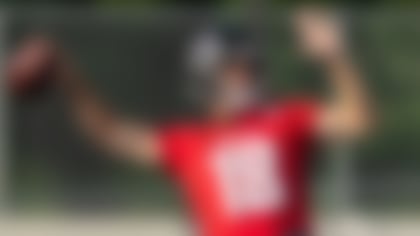As important as your workouts are, your rest and recovery routines are just as important. In my 30 years as a medical professional in the sports medicine field, I have seen many athletes physically and mentally exhaust themselves or "hit the wall." Subsequently, their performance declined and/or they were injured.
The implementation of effective recovery strategies will not only have you avoiding exhaustion, but actually improve your performance on the playing field.
Here are a few methods to maximize your recovery:
NFL Up!

Watch more NFL Player workouts for great training tips. More...
1. Proper nutrition refueling your body after a tough session is a must
Depleted electrolyte and glycogen levels, as well as muscle tissue damage, often occur during an intense workout. The first priority is to rehydrate. The actual recovery process should start by drinking 17-20 ounces of water or sports drink two to three hours pre-workout. Then drink another seven to 10 ounces 10 to 20 minutes before the workout. During the exercise, drink seven to 10 ounces every 10 to 20 minutes in a shaded area. Also, avoid soda pop or carbonated drinks of any kind during the session.
The post workout goal is to consume 125 to 150 percent of the fluids lost. This process of total refilling should be completed within two hours of the workout. This post event hydration should contain water to restore hydration levels, carbohydrates to replenish glycogen stores and electrolytes to speed the rehydration process.
Now that hydration levels are replenished, a combination of carbohydrates (fruits, vegetables, breads, pasta, etc.) and quality proteins (around 20-30 grams) are needed within 45-60 minutes of the workout to help the body recover and repair. If food is not available, a ready-to-drink shake or powder product is ideal for getting quality carbohydrates and proteins.
2. Active recovery
A proper cooldown after the workout can significantly reduce post-exercise soreness. Active recovery consists of easy, low-level and gentle exercises that work the muscles for at least 10 minutes to allow for circulation of blood throughout the body. This helps to eliminate any waste products such as lactic acid. Active recovery can include a light jog, bike, swim or light movements to oxygenate the body tissue.
During this active recovery period, I have found it beneficial to include three-dimensional stretching or yoga poses to assist the process.
3. Cold tubs/contrast baths/hot tubs
Another effective method to promote recovery is the use of cold tubs, hot tubs and contrast baths.
Cold tub plunges should last around 10 minutes at 50 to 59 degrees, and will cause immediate constriction of the blood vessels. Then, after being in the cold tub for 10 minutes, the blood vessels will dilate and "new" nutrient rich blood from other parts of the body will be transported back to the muscle regions creating a flush-like effect to the lactic acid.
Contrast baths are the alternating of cold tub plunges and hot tubs. In order to be effective, this must be done within 30 minutes of workout completion. The cold tub should be 50 to 59 degrees and the hot tub should be 95 to 100 degrees. Start this process by going into the cold tub for one minute followed by three minutes in the hot tub. Complete this cycle four times and finish with an additional minute in the cold tub.
Hot tubs will cause blood vessel dilation, which brings vital nutrients to muscles and body tissue. I've seen better results for immediate post-workout recovery by use of cold tubs or contrast baths. I believe hot tubs are most effective when they're used 12 to 24 hours post workout because of dehydration issues, or used a few hours pre-workout to help warm up the muscles.
4. Professional assistance (massage, joint manipulation, acupuncture/dry needling)
The benefits of massage are many, including increased blood flow, thus improving nutrients to a specific area. Other benefits include relaxation, endorphin release (body's own natural painkillers) and improved flexibility.
Joint manipulation performed by licensed medical practitioners can have a huge influence on restoring the athlete's ability to move effectively and enhance sports performance.
Acupuncture/Dry Needling is the use of needles by licensed medical professionals to help promote tissue healing. Acupuncture is based on the theoretical framework of Traditional Chinese Medicine (TCM) in which the needles are strategically placed along specific meridians that theoretically alters the flow of Qi, or energy flow, whereas dry needling is based on a traditional western musculoskeletal framework. Dry needling includes, but it is not limited to, the needling of taut bands of muscle (i.e. trigger points), but also perineural needling and needle puncture of tendons, ligaments, musculotendinous junctions and bone.
5. Rest & sleep
Rest is often an overlooked option to maximizing recovery. Many times, some of the world's best and most driven athletes do not give their bodies enough time to recover and repair in between workouts. Finding that happy medium of work to rest to maximize performance is a must. Finding this delicate balance depends on many factors, such as intensity and duration of the workout, which body parts were emphasized, athletes age, medical history and condition, scheduling, personal life requirements, nutrition and sleep habits to name a few.
Proper sleep is paramount in effectual recovery. Experts state that at least 7.5 to 8 hours of sleep a day are needed to maximize recovery. To improve the ability to sleep, sleep in a dark or low-lit cool room while lying on a comfortable bed.
- Brett Fischer is the owner/founder of the Fischer Institute in Phoenix, Ariz. He is a licensed physical therapist, certified athletic trainer, certified strength and conditioning specialist and a certified dry needling provider. He has worked with the University of Florida, New York Jets, PGA & Senior PGA TOUR and the Chicago Cubs.



